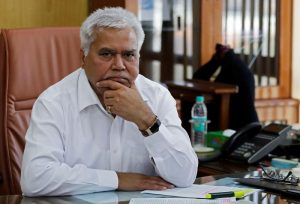In crowdfunding platforms, a surge in fundraisers for children needing urgent liver transplants

KV Prasad Jun 13, 2022, 06:35 AM IST (Published)
 Listen to the Article (6 Minutes)
Listen to the Article (6 Minutes)
Summary
Crowdfunding platforms such as Milaap, Ketto and ImpactGuru are swelling with medical fundraisers for infants and children needing urgent liver transplants.
This story began with a contribution and then an observation. Last month, I made a donation towards a child suffering from end-stage liver disease on a leading crowdfunding platform. I was soon inundated with emails and online adverts from various platforms seeking contributions for children suffering from terminal illnesses.
What stood out in these messages was the high incidence of liver-related cases. It seemed to me one in three campaigns were for infants or children from poor families who needed a liver transplant to survive. The imagery was disconcerting: infants lying frugally on hospital beds with swollen tummies and yellowed eyes; inconsolable parents pleading to save their child’s life through a generous hand-out.
Young lives crushed
I was both disturbed and piqued. Why do so many children suffer from end-stage liver disease so early on in their lives? How endemic is this problem? I knocked on the doors of leading crowdfunding platforms, Milaap, Ketto and ImpactGuru, and was taken aback by the magnitude of the issue. End-stage liver disease featured among the top three illnesses among children raising funds through their platforms.
Executives of Bengaluru-based Milaap, South Asia’s largest crowdfunding platform, say paediatric liver ailments account for the largest share of medical fundraisers for children supported by the platform. Data provided by Milaap says it has supported 12,000 medical fundraisers for children (0-18 years) to date, which have altogether raised more than Rs 155 crore. Of these, nearly 1,500 fundraisers have been for children with liver-related ailments, which have raised nearly Rs 35 crore. Milaap claims it has directly or indirectly aided over 50 percent of paediatric liver transplants performed in the country till date.
For Mumbai-based platform Ketto, paediatric liver ailments have steadfastly accounted for 20 percent of all the medical fundraisers for children over the past three years. A fourth of these children hailed from Below Poverty Line (BPL) families. Mumbai-based ImpactGuru has observed fewer than 100 cases of children with terminal illnesses each year. Of these, 20 percent are of children with liver-related ailments with most hailing from BPL/lower socio-economic backgrounds. CNBC-TV18.com could not independently verify the data provided by the platforms.
The emergence of children with failing livers on crowdfunding platforms subsets the larger problem the country faces. According to the latest World Health Organisation data published in 2017, liver diseases caused 259,749 deaths, translating to nearly 3 percent of total deaths in the country. This makes it the ninth leading cause of death in India, says The Pravin Agarwal Foundation (TPAF), a not-for-profit that supports paediatric liver transplants in India, in a blog post titled ‘Creating an affordable paediatric liver transplant ecosystem’, which was published in June.
Numbers quoted by TPAF on paediatric liver mortality are equally grim. Pediatric disease is one of the least recognised causes of mortality in India. Nearly 3,000 children need a liver transplant every year but only one in 20 gets access to it. This means a staggering 92 percent of children in need of a transplant do not receive it due to a variety of reasons including dearth of organ donors, lack of an organised system for liver procurement, poor financial condition of families and lack of awareness/illiteracy.
The many causes of liver-ailments in children
Liver diseases among children can have various causes. Children may either be born with a genetic disease (biliary atresia), may develop a metabolic disorder (Wilson disease) or may contract an infection in the early part of their infancy (hepatitis). In the case of biliary atresia, a child is born with blocked or damaged bile ducts which hinder the flow of bile into the intestines, causing it to accumulate in the liver and damage it. In metabolic liver diseases like Wilson disease, the body is unable to process copper from food and the copper builds up in the liver. Children may also contract chronic viral hepatitis which causes the liver to swell and encourages scar tissue to form. While medication is used to manage these ailments in the early part of treatment, a liver transplant is the only option for long-term survival.
Given the alarming number of cases coming to light, a pertinent question is: Has the incidence of paediatric liver-ailments increased over the years? Doctors do not think so. “It’s difficult to say whether incidences have increased but surely diagnosis has increased,” said Dr Swapnil Sharma, liver transplant and hepatobiliary surgeon at Fortis Hospital in Mulund, Mumbai.
“Improved awareness levels, early referral by primary physicians and scientific advancement have helped in increasing diagnosis of liver ailments in children. Today, medical science has evolved with newer imaging and tissue analysis procedures available, such as HIDA scans,” he said. A HIDA scan, also called cholescintigraphy or hepatobiliary scintigraphy, is an imaging test used to view the liver, gallbladder, bile ducts, and small intestine by injecting a radioactive tracer into a person’s veins.
Dr Sonal Asthana, senior consultant – hepato pancreato biliary and liver transplant surgeon at Aster CMI Hospital, Bengaluru, said: “The detection for liver problems is now more effective than before. Their identification is better. The referral channel for children is better today. Children are being referred more appropriately for transplants. So we cannot really say there is an increase in incidence; we are probably getting better at identifying these patients.”
The economic background of these children is another point of observation. A large number of children raising funds through crowdfunding platforms hail from poor families where mothers are homemakers and fathers tend to be farmers, daily wage workers or in low-paid blue-collared jobs. That raises the question: Are children from economically disadvantaged sections of society more susceptible to compromised livers at birth or to falling prey to liver diseases?
“Yes. This is for a number of reasons. Children from certain groups of communities, for example, tribal communities, do have higher incidence of certain particular genetic disorders, and that is well-known and well-studied. Secondly, children from poorer families are more likely to come from malnourished mothers, who have prematurity and several of the attendant problems. So these children not only have a higher incidence of some of these diseases, but they present to us in a much worse fashion with diseases, because they are combined with other conditions like anaemia that go hand-in-hand with poverty. So most of these kids come to us very late, if at all,” explained Dr Asthana.
“Children from all economic backgrounds suffer from liver diseases. The difference lies in the nature of illness. A few conditions such as infections e.g. Hepatitis A, E, liver abscess are more commonly seen in children with poor sanitation facilities. Children from poor socio-economic backgrounds also suffer from liver ailments such as infections and fatty liver due to malnutrition. Some perinatal disorders like biliary atresia may be caused by as yet unidentified factors including probable infections that may be commoner in poor socioeconomic strata. Those from affluent families suffer from obesity and related liver issues. However, there is no strict distinction.” says Dr Smita Malhotra, pediatric gastroenterologist, Apollo Hospitals, Delhi.
“Kids from impoverished backgrounds are the ones who are affected the most, as they are exposed to unhygienic conditions, leading them to fall prey to liver ailments. The lack of basic sanitation, good drinking water and healthy food supply is the main cause for the rising number of liver failure cases amongst children,” says Varun Sheth, co-founder and CEO, Ketto.
‘Overwhelming challenges to the paediatric liver ecosystem’
The paediatric liver ecosystem is highly underrepresented in India, despite the urgency the disease demands.
A liver transplant is a highly time-bound procedure, more so in babies and children who have lower immunity than adults. According to the Directorate General of Health Services, of the nearly 260,000 fatalities caused by liver diseases, 200,000 can be attributed directly to cases of liver failure and that on-time administration of a liver transplant could have saved an astonishing 10-15 percent of these lives.
Unfortunately, the poor status of families and lack of awareness or outright illiteracy means they are unable to access the right treatment options in a quick manner. Many families live in villages or towns with either no medical facilities or are dependent on basic community health care centres for the first line of treatment, where liver-related symptoms are often misdiagnosed as pre-natal jaundice. Months of incorrect medication and treatments cost patients their livers, which are most often decompensated by the time they approach tertiary healthcare centres in larger cities. The time lost can prove to be fatal in many cases.
Secondly, despite transplants costs in India being the lowest in the world, it is still well beyond the reach of Indian middle-class families. Among transplants of critical organs such as kidney, liver and heart, a liver transplant is the most expensive, with costs ranging between Rs.15-30 lakh. The high cost is attributable to a significant demand-supply mismatch on two accounts: between donors and recipients and super-speciality doctors and hospitals equipped to perform liver transplants.
As pointed out in the blog penned by the TPAF, a lion’s share of paediatric liver transplants is facilitated by a liver donation from a living, adult donor. While in many cases the living donor is the child’s mother or father, convincing unrelated adults to donate a part of their liver is very challenging. The lack of awareness around the concept of a living donor proves to be a big setback with misconceptions aplenty – prospects often think they would be handicapped or diseased after donating a part of their liver.
Finding a match from a deceased donor is equally difficult. “The awareness and attitude towards paediatric liver donation continue to be poor. While medical science allows the liver of a recently deceased person to be transplanted, convincing a prospect’s family to volunteer for donation is difficult. This results in a poor deceased organ donation rate. Combining the first and the second factor leads to a high imbalance between the demand and supply of paediatric livers,” reads the blog.
The dearth of doctors qualified to perform liver transplants and lack of hospitals is another factor leading to the high cost. “In Mumbai, barely 4-5 hospitals have the licence to perform liver transplants. While many hospitals may be state-of-the-art, there is a huge scarcity of super-speciality doctors and teams qualified to perform paediatric liver transplants, which is a highly complicated surgery. And this is the situation in India’s biggest and most popular city, so one can imagine the story in a tier-2 city,” explained Sandeep Tripathy, Senior VP – Business Development, ImpactGuru.com
“Even where doctors are available, hospitals may not be able to afford them or they may not fit into their revenue criteria. Most hospitals operate on 10-15 percent EBIDTA margins and their cash flows are often stretched, disincentivising them to offer transplant surgeries,” said Sheth of Ketto.
As Tripathy pointed out, a liver transplant is a highly complex surgery, involving two surgeries (extracting the liver from donor and transplanting into recipient) and the high post-operative costs included in the liver transplant budget significantly inflates the costs borne by affected families. Most families do not have insurance coverage and those who do may find their covers insufficient to take care of the entire cost of the transplant and beyond.
More so, the government’s ambitious national health mission programme, Ayushman Bharat, which aims at providing Rs 5 lakh medical insurance to 10 crore Indians, covers chemotherapy and radiation costs for cancer patients but does not cover organ transplant. While news reports suggest the government is contemplating including organ transplant in the second phase of the program, experts say there are miles to go before it becomes a reality.
Together, these factors make liver transplants well beyond the reach of those who require it.
Crowdfunding comes to the rescue
The emergence of crowdfunding as a platform to raise funds for emergency or tertiary healthcare has come as a ray of hope to families crushed under the burden of hospital bills. In most cases, crowdfunding is not the only source of funding, and is often the last resort after exhausting all other avenues. Doctors say crowdfunding platforms produce better results than NGOs or charitable trusts, with campaigns for children raising at least 70-80 percent of the expected amount, if not more.
“Charitable trusts have to distribute their funds equitably among different causes or beneficiaries and therefore, the amounts are capped. Crowdfunding campaigns focus exclusively on the patient and rely on the generosity of the general public. In the case of young children, people tend to be more generous and therefore, the amounts raised have been handsome,” said Dr Somnath Chattopathyay, consultant and head of hepatobiliary surgery and liver transplant at Kokilaben Dhirubhai Ambani Hospital in Mumbai.
Take the case of six-month-old Adrika Das who was diagnosed with a rare genetic liver disorder Prothrombotic Disorder (Protein C Disorder) after birth. Adrika suffered from necrosis on various body parts and was referred to Rela Institute in Chennai for a liver transplant. It is here that her father, Dipanjan, a government employee, was approached by a representative from Milaap. The campaign was kick-started by Milaap and widely shared by Dipanjan and his family. The campaign raised an astounding sum of Rs 33 lakh overnight, which not only covered Adrika’s liver transplant but also a follow-up surgery to remove part of her intestine.
“I have no words to describe how grateful I am to Milaap. Raising Rs 33 lakh was beyond my imagination. The power of crowdfunding is immense,” said Dipanjan.
Another example is that of one-year-old Piyush who was born with Biliary Atresia. Piyush, abandoned by his father after birth, was required to undergo a liver transplant at the earliest. Given the high cost, the family opted for crowdfunding on ImpactGuru. Within 24 hours, the campaign raised Rs 21.91 lakh, helping Piyush undergo a liver transplant At Fortis Hospital, Mulund. Piyush’s grandmother turned out to be a match, and 30 percent of her liver was transplanted to save Piyush.
Pooja Sarkar, 21, Piyush’s aunt said: “The treating doctor referred us to ImpactGuru and the team seamlessly set up a campaign for Piyush. We would have never been able to raise such a significant sum on our own.”
Reasons why campaigns run for children tend to be more successful are aplenty. One, children not only evoke unparalleled feelings of sympathy and generosity, but the sense of gratification of saving a child, who has his/her entire life ahead of him, is immense. The second is the high success rates that paediatric transplants enjoy. Anoj Viswanathan, president and co-founder, Milaap, said: “Crowdfunding opens up an alternate financing option for such medical emergencies, and liver transplants, in particular, are a kind of treatment with higher success rates, particularly among children. Urgency is one of the key psychological triggers that cause people to donate, needs like these are more likely to receive support online.”
Pediatric liver transplants enjoy high success rates with one year post-surgery survival rate at 95 percent, 10-year post-surgery survival rate at 85 percent and 20-year post-surgery rate at 80 percent. This data, corroborated by several doctors, is true for pan-India.
Building the paediatric liver ecosystem
While crowdfunding is becoming an important channel for those who fall out of the entitlement bracket, it certainly isn’t the only intervention that is required. Doctors say it is critical that the costs of liver transplants, including post-operative costs, are brought down.
“Crowdfunding platforms, with all respect are a bit of a double-edged sword, because it relies on an emotional connect with online communities to raise money for a treatment that would not ordinarily be within the reach of a particular family. So it’s extremely good when it comes to acute problems, for example when a child needs chemotherapy, or if somebody has an accident. But when it comes to something as complex as transplantation, we need to be sure that we have an on-going mechanism of supporting families for on-going expenses because transplantation is not a one-time expense. It involves a fairly high upfront expense, but it also involves lifelong care and medication for a child,” explained Dr Asthana.
“The high expenses are not a reflection on crowdfunding itself, because it is obviously a very valuable tool, but it is more of a reflection on our healthcare system, where we aren’t able to put down safeguards for long-term care for these children. So the best way is to marry something like crowdfunding with an on-going government scheme which would provide for on-going care of children undergoing treatment. So I think crowdfunding is just part of the answer, not the entire answer,” he said.
Post-liver transplant management requires life-long screening tests and administration of steroids and immunosuppressants (to prevent liver rejection by the body) and these post-operative expenses are difficult to bear for most families. Doctors concur that the government should arrange for free blood tests and subsidised or free transplants for BPL families, as the Tamil Nadu government does.
Piyush, who underwent liver transplant at Fortis Hospital, is an example. Said Piyush’s aunt Pooja, “While crowdfunding helped us with the expenses of the operation, managing the post-operative expenses is challenging. Each month, we incur an expense of Rs 20,000 on Piyush’s blood tests and medication. We rely entirely on our personal savings.”
Doctors said it is imperative that hospitals offer discounted packages for transplant cases, especially in cases where crowdfunding is being sought to raise funds. “Hospitals must voluntarily agree to a lower share of profit by agreeing to discount packages by 10-15 percent to support these patients. It must be treated as part of their social responsibility,” said Dr Smita Malhotra of Apollo Hospitals.
Ketto chief Varun Sheth believes it is important for hospitals and foundations to work together to bring down transplant costs. Sheth explains the concept of “group buying”, citing the example of the Transplants-Help the Poor Foundation (THPF) which works with Apollo Hospitals. Under this, THPF supports a large volume of patients to get a discounted cost per transplant from the hospital. Sheth also stresses on the importance of reducing taxes on medical devices and fixing prices on essential drugs to lower costs.
Not all seem convinced by efforts to bring down healthcare costs. “These institutions are trying their bit to reduce liver transplant costs by trying to negotiate the cost of a liver transplant with hospitals. They aim to aggregate the supply of people who want transplants for children and therefore, try to negotiate bulk rates with hospitals. It’s a great thought process, wonderful intervention. But having worked with thousands of hospitals across the country and having personally funded through the platform 6000+ patients, I can tell you bringing healthcare costs down is a myth,” said Piyush Jain, co-founder and CEO, ImpactGuru.
“Generally speaking, costs will keep increasing; because what is the driver of the costs? The doctors’ fee, cost of materials and machine and technology; none of these go down. But what can be done is thoughtful thinking on how to arrange the financing required for these emergencies. And that is where most of the effort needs to go into,” he said.
Jain pointed out that Corporate Social Responsibility (CSR) is one such area where strategic interventions are required. He says, “India is spending $2 billion of CSR funds on so many interventions with non-profits. Whatever way it is being spent, it can be more efficient. The vast majority of funds go into preventive healthcare, because it allows companies to show good, strong numbers. For example, a camp set up to offer free eye checkup to 5 lakh people is equivalent to the cost of one liver transplant. More funds need to be channelised into curative healthcare to make it more affordable for the masses.”
CSR funds can also play a pivotal role where crowdfunding efforts do not succeed. “CSR funds can provide a matching fund or backstop; if crowdfunding cannot raise a certain amount of money within a certain period, CSR funds can be deployed,” explained Jain.
Another important area to address is the shortage of multi-speciality hospitals and doctors. Dr Swapnil Sharma of Fortis Hospital said: “Every state must set up government or semi-government aided liver speciality centres, an example being the Institute of Liver and Biliary Sciences (ILBS), where liver patients from the state can be referred. These hospitals would perform transplants at a much lower cost than private hospitals and would attract top speciality doctors.
“That said, several multi-speciality government hospitals are facing a shortage of super-speciality doctors due to the low pay they offer. If this is corrected, it will incentivise doctors to serve government hospitals,” he said.

Elon Musk forms several ‘X Holdings’ companies to fund potential Twitter buyout
3 Mins Read
Thursday’s filing dispelled some doubts, though Musk still has work to do. He and his advisers will spend the coming days vetting potential investors for the equity portion of his offer, according to people familiar with the matter

KV Prasad Journo follow politics, process in Parliament and US Congress. Former Congressional APSA-Fulbright Fellow










 Listen to the Article
Listen to the Article  Daily Newsletter
Daily Newsletter













